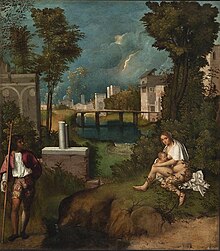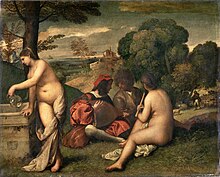Le Déjeuner sur l'herbe: Difference between revisions
Luckas-bot (talk | contribs) m robot Adding: fi:Aamiainen ruohikolla |
m →Works inspired by Déjeuner: added an art film and art photo (20th century) inspired by the concept of the work |
||
| Line 45: | Line 45: | ||
*[[Claude Monet]] included a portrait of [[Gustave Courbet]] in his own version of ''[[Le dejeuner sur l'herbe]]'' from 1865–1866, inspired by Manet's masterpiece. |
*[[Claude Monet]] included a portrait of [[Gustave Courbet]] in his own version of ''[[Le dejeuner sur l'herbe]]'' from 1865–1866, inspired by Manet's masterpiece. |
||
*Manet's painting inspired [[Picasso]] to a cycle of 27 paintings, 140 drawings, 3 linogravures and cardboard marquettes for sculpture carried out between 1949 and 1962<ref>''Picasso: Challenging the past'' [[National Gallery (London)|National Gallery]] exhibition book, p116</ref> |
*Manet's painting inspired [[Picasso]] to a cycle of 27 paintings, 140 drawings, 3 linogravures and cardboard marquettes for sculpture carried out between 1949 and 1962<ref>''Picasso: Challenging the past'' [[National Gallery (London)|National Gallery]] exhibition book, p116</ref> |
||
*It also inspired the cover of the [[Bow Wow Wow]] EP ''[[The Last of the Mohicans (Bow Wow Wow EP)|The Last of the Mohicans]]'', which caused additional controversy since the naked girl (lead singer Annabella Lwin) was only 14 at the time. |
*It also inspired the 1959 [http://www.imdb.com/title/tt0052765/ film] by [[Jean Renoir]], the 1974 [http://photo.net/photodb/photo?photo_id=4046916 photo] by [http://www.jonathancharlesphoto.com/ Jonathan Charles] and the cover of the [[Bow Wow Wow]] EP ''[[The Last of the Mohicans (Bow Wow Wow EP)|The Last of the Mohicans]]'', which caused additional controversy since the naked girl (lead singer Annabella Lwin) was only 14 at the time. |
||
==References== |
==References== |
||
Revision as of 14:21, 1 July 2010
| The Luncheon on the Grass | |
|---|---|
| French: Le déjeuner sur l'herbe | |
 | |
| Artist | Édouard Manet |
| Year | 1862–1863 |
| Type | Oil on canvas |
| Location | Musée d'Orsay, Paris |
Le déjeuner sur l'herbe (French, "The Lunch on the Grass") — originally titled Le Bain (The Bath) — is a large oil on canvas painting by Édouard Manet. Created in 1862 and 1863, its juxtaposition of a female nude with fully dressed men sparked controversy when the work was first exhibited at the Salon des Refusés. The piece is now in the Musée d'Orsay in Paris. A smaller, earlier version can be seen at the Courtauld Gallery, London.[1]
Description
In 1863, Manet shocked the French public by exhibiting his Déjeuner sur l'Herbe ("Luncheon on the Grass"). It is not a realist painting in the social or political sense of Daumier, but it is a statement in favor of the artist's individual freedom. The shock value of a woman, naked as can be, casually lunching with two fully dressed men, which was an affront to the propriety of the time, was accentuated by the familiarity of the figures. Manet's wife, Suzanne Leenhoff, and his favorite model, Victorine Meurent, both posed for the nude woman, which has Meurent's face, but Leenhoff's plumper body.[citation needed] Her body is starkly lit and she stares directly at the viewer. The two men are Manet's brother Eugene Manet and his future brother in law, Ferdinand Leenhoff. They are dressed like dandies. The men seem to be engaged in conversation, ignoring the woman. In front of them, the woman's clothes, a basket of fruit, and a round loaf of bread are displayed, as in a still life. In the background a lightly clad woman bathes in a stream. Too large in comparison with the figures in the foreground, she seems to float above them. The roughly painted background lacks depth — giving the viewer the impression that the scene is not taking place outdoors, but in a studio. This impression is reinforced by the use of broad "photographic" light, which casts almost no shadows: in fact, the lighting of the scene is inconsistent and unnatural. The man on the right wears a flat hat with a tassel, of a kind normally worn indoors.
Despite the mundane subject, Manet deliberately chose a large canvas size, normally reserved for grander subjects. The style of the painting breaks with the academic traditions of the time. He did not try to hide the brush strokes: indeed, the painting looks unfinished in some parts of the scene. The nude is a far cry from the smooth, flawless figures of Cabanel or Ingres.
Commentary of Émile Zola
The Luncheon on the Grass is the greatest work of Édouard Manet, one in which he realizes the dream of all painters: to place figures of natural grandeur in a landscape. We know the power with which he vanquished this difficulty. There are some leaves, some tree trunks, and, in the background, a river in which a chemise-wearing woman bathes; in the foreground, two young men are seated across from a second woman who has just exited the water and who dries her naked skin in the open air. This nude woman has scandalized the public, who see only her in the canvas. My God! What indecency: a woman without the slightest covering between two clothed men! That has never been seen. And this belief is a gross error, for in the Louvre there are more than fifty paintings in which are found mixes of persons clothed and nude. But no one goes to the Louvre to be scandalized. The crowd has kept itself moreover from judging The Luncheon on the Grass like a veritable work of art should be judged; they see in it only some people who are having a picnic, finishing bathing, and they believed that the artist had placed an obscene intent in the disposition of the subject, while the artist had simply sought to obtain vibrant oppositions and a straightforward audience. Painters, especially Édouard Manet, who is an analytic painter, do not have this preoccupation with the subject which torments the crowd above all; the subject, for them, is merely a pretext to paint, while for the crowd, the subject alone exists. Thus, assuredly, the nude woman of The Luncheon on the Grass is only there to furnish the artist the occasion to paint a bit of flesh. That which must be seen in the painting is not a luncheon on the grass; it is the entire landscape, with its vigors and its finesses, with its foregrounds so large, so solid, and its backgrounds of a light delicateness; it is this firm modeled flesh under great spots of light, these tissues supple and strong, and particularly this delicious silhouette of a woman wearing a chemise who makes, in the background, an adorable dapple of white in the milieu of green leaves. It is, in short, this vast ensemble, full of atmosphere, this corner of nature rendered with a simplicity so just, all of this admirable page in which an artist has placed all the particular and rare elements which are in him.[2]
Zola presents a fictionalised version of the painting and the controversy surrounding it in his novel L'Œuvre (The Masterpiece).
Inspirations

Gallerie dell'Accademia, Venice, Italy


Manet's composition reveals his study of the old masters, as the disposition of the main figures is derived from Marcantonio Raimondi's engraving The Judgement of Paris (c. 1515) after a drawing by Raphael.[3]
Scholars also cite two works as important precedents for Manet's painting Le déjeuner sur l'herbe, The Pastoral Concert, 1508, by Giorgione or possibly Titian (in the Louvre) and Giorgione's The Tempest, both of which are famous Renaissance paintings.[4] The Tempest, is a famous Renaissance painting that also features a fully dressed man and a nude female in a rural setting, as an important precedent for Manet's painting Le déjeuner sur l'herbe.[5] The painting Pastoral Concert, even more closely resembles Le déjeuner sur l'herbe, featuring two dressed men seated in a rural setting, with two undressed women. Pastoral Concert, is in the collection of the Louvre in Paris making it more likely to have been studied by Manet.
Controversy
This famous painting has remained controversial, even to this day. Odilon Redon, for example, did not like it. There is a discussion of it, from this point of view, in Proust's Remembrance of Things Past.
One interpretation of the work is that it depicts the rampant prostitution that occurred in the Bois de Boulogne, a large park at the western outskirts of Paris, at the time. This prostitution was common knowledge in Paris, but was considered a taboo subject unsuitable for a painting.[6] Indeed, the Bois de Boulogne is to this day known as a pick-up place for prostitutes and illicit sexual activity after dark, just as it had been in the 19th century.
Works inspired by Déjeuner

- Claude Monet included a portrait of Gustave Courbet in his own version of Le dejeuner sur l'herbe from 1865–1866, inspired by Manet's masterpiece.
- Manet's painting inspired Picasso to a cycle of 27 paintings, 140 drawings, 3 linogravures and cardboard marquettes for sculpture carried out between 1949 and 1962[7]
- It also inspired the 1959 film by Jean Renoir, the 1974 photo by Jonathan Charles and the cover of the Bow Wow Wow EP The Last of the Mohicans, which caused additional controversy since the naked girl (lead singer Annabella Lwin) was only 14 at the time.
References
- ^ Details at www.artandarchitecture.co.uk
- ^ Émile Zola, Édouard Manet, 1867, et lps 91
- ^ Ross King. The Judgment of Paris: The Revolutionary Decade that Gave the World Impressionism. New York: Waller & Company, 2006 ISBN 0802714668.
- ^ Paul Hayes Tucker, Manet's Le Déjeuner sur l'herbe, Cambridge University Press, 1998, pp.12-14. ISBN 0-521-47466-3.
- ^ John Rewald,The History of Impressionism, The Museum of Modern Art, 4th revised edition 1973, (1st 1946, 2nd 1955, 3rd 1961), p.85. ISBN 0-87070-369-2.
- ^ Peter J. Gartner, Art and Architecture: Musee D'Orsay, 2001, p.180. ISBN 0-7607-2889-5.
- ^ Picasso: Challenging the past National Gallery exhibition book, p116

